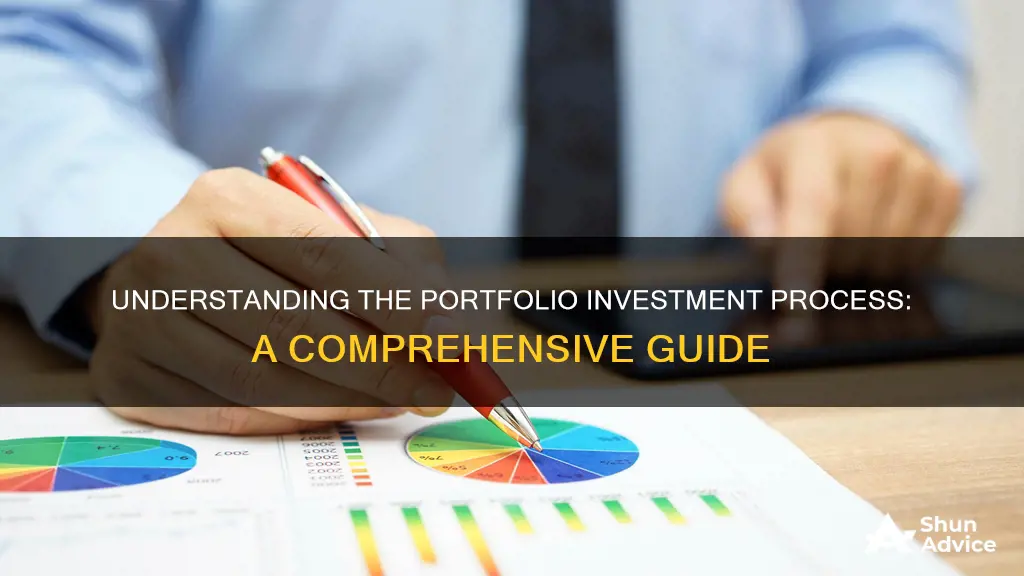
Portfolio investment is the process of acquiring and managing a range of financial assets, such as stocks, bonds, commodities, and other securities, with the goal of maximising returns and minimising risk. The process typically involves several steps, including planning, implementation, and monitoring.
The first step is to establish clear investment goals and assess one's financial situation, including assets, liabilities, cash flow, and risk tolerance. This is followed by deciding on the types of assets to invest in, such as stocks, bonds, cash, or alternative investments, based on one's goals, risk tolerance, and investment timeline. The next step is to select specific investments within each asset class.
Portfolio managers play a crucial role in this process, providing investment advice and making decisions on behalf of their clients. They aim to reduce risk and increase returns for investors, taking into account market conditions and the investor's financial capabilities.
The portfolio investment process also involves regularly monitoring and rebalancing the portfolio to ensure it remains aligned with the investor's goals, risk tolerance, and market conditions. This may include buying or selling assets to maintain the desired asset allocation.
By following these steps, individuals can effectively manage their investment portfolios, maximising returns while minimising risk to build long-term financial security.
| Characteristics | Values |
|---|---|
| Purpose | To reduce risk and increase return to the investor |
| Objective | To meet the investment objectives of an investor |
| Steps | Planning of portfolio, implementation of portfolio plan, monitoring the performance of portfolio |
| Planning | Understanding the purpose of the security portfolio, the investor's financial capability and current capital market situation |
| Implementation | Re-balancing the portfolio to the desired Strategic Asset Allocation |
| Monitoring | Upgrading activity in asset composition to take advantage of economic, industry and market conditions |
What You'll Learn

Planning of Portfolio
Planning is the most important element of portfolio management. The success of portfolio management depends on careful planning. A portfolio plan should be made with due consideration of the investor's financial capability and the current capital market situation. After taking these into account, a set of investment and speculative policies should be prepared in writing, known as a statement of investment policy.
The planning document must clearly define the asset allocation, which means an optimal combination of various assets in an efficient market. The portfolio manager must be mindful of the difference between basic pure investment portfolio returns and actual portfolio returns. The statement of investment policy may contain the following elements:
Investor Conditions
The first question to answer is: "What is the purpose of the security portfolio?" Understanding the purpose of trading in financial securities will help to define the expected portfolio liquidation, determine an acceptable level of risk, and indicate whether future consumption (liability needs) should be paid in nominal or real money. For example, a 60-year-old woman with small to moderate savings will likely have a short investment horizon, a low tolerance for investment risk, and a need for protection against short-term inflation. In contrast, a young couple investing for retirement in 30 years will have a much longer investment horizon and a higher tolerance for risk.
Market Conditions
The portfolio owner must be aware of the latest market developments to assess the potential for future returns on various capital market instruments. Investors' expectations can be of two types: long-term and short-term. The most important investment decision in portfolio construction is asset allocation, which refers to investing in different financial instruments at a certain percentage. Some investment strategies are static, while others require continuous changes according to the investor's needs and knowledge. Generally, the potential volatility of equity and debt markets is 2 to 3 years.
Speculative Policies
The portfolio owner may accept speculative strategies to maximize their earnings. Speculative strategies can be categorized as asset allocation timing decisions or security selection decisions. Small investors can purchase mutual funds indexed to stocks, while organizations with large capital can employ investment management firms to make these decisions.
Strategic Asset Allocation
The most important investment decision the owner of a portfolio must make is the portfolio's asset allocation. Asset allocation refers to the percentage invested in various security classes, such as money market investments, fixed-income obligations, equity shares, real estate investments, and international securities. Strategic asset allocation represents the optimal asset allocation for the investor if all security prices trade at their long-term equilibrium values.
Saving and Investing: Key Factors for Decision-Making
You may want to see also

Implementation of Portfolio Plan
The implementation stage of the portfolio investment process involves putting the portfolio plan into action. This stage requires making three key decisions:
- Rebalancing the portfolio: If the current percentage holdings of various asset classes deviate from the desired holdings, the portfolio should be rebalanced to align with the Strategic Asset Allocation (SAA). The SAA represents the optimal allocation of assets based on the investor's goals and risk tolerance.
- Pure investment strategy: If the portfolio plan calls for a pure investment strategy, this is the only action required in the implementation stage. A pure investment strategy focuses on long-term gains and typically involves investing in a diverse range of assets to reduce risk.
- Speculative transactions: Portfolio owners may engage in speculative transactions, such as "timing" or "selection" decisions, believing they will generate excess risk-adjusted returns. Timing decisions involve overweighting or underweighting various asset classes, industries, or economic sectors from the SAA. Selection decisions involve actively choosing specific securities within a given asset class, industry, or economic sector that are believed to be temporarily mispriced.
The implementation stage is crucial as it translates the portfolio plan into concrete actions, ensuring that the portfolio is managed in a way that aligns with the investor's goals and risk tolerance. It is important to note that the implementation stage may require adjustments over time as market conditions change and new information becomes available.
Tactical Asset Allocation
Tactical asset allocation is a type of timing decision where the portfolio manager believes that the price levels of certain asset classes, industries, or economic sectors are temporarily too high or too low. In such cases, the actual portfolio holdings should deviate from the SAA. For example, if equity prices are believed to be too high, the portfolio manager may reduce the allocation to equities and increase the allocation to risk-free securities. Tactical asset allocation aims to take advantage of short-term pricing discrepancies and generate abnormal returns.
Security Selection
Security selection is a type of active speculation where the portfolio manager selects specific securities within a given asset class, industry, or economic sector. This involves overweighting or underweighting particular securities based on the belief that they are temporarily mispriced. Security selection is a more targeted approach than tactical asset allocation, as it involves choosing individual securities rather than making broad asset class allocations.
Structuring an Investment Portfolio: Strategies for Success
You may want to see also

Monitoring the Performance of Portfolio
Monitoring the performance of a portfolio is an ongoing process that requires regular reviews and adjustments to stay aligned with the investor's financial goals, risk tolerance, and market conditions. Here are some key aspects of monitoring the performance of a portfolio:
- Frequency of Monitoring: The frequency of monitoring can vary depending on the investor's goals and investment style. A common approach is to monitor the portfolio quarterly (every three months), as investment data is typically reported during earnings season on a quarterly basis. However, it is important to strike a balance between active monitoring and a "set it and forget it" approach.
- Performance Benchmarks: Selecting appropriate performance benchmarks is crucial for effective portfolio monitoring. Common benchmarks include the S&P 500 for stock portfolios and the Barclays US Aggregate Bond Index for fixed-income portfolios. Investors can also use multiple benchmarks or a balanced index fund that matches their asset allocation.
- Risk Assessment: In addition to return on investment, it is essential to consider the risk involved in achieving those returns. Various statistical measures, such as standard deviation, beta, R-squared, Sharpe ratio, and Sortino ratio, can be used to assess the volatility and risk-adjusted returns of a portfolio.
- Rebalancing: Regularly rebalancing the portfolio is crucial to maintaining the desired asset allocation. Market movements can cause shifts in the portfolio's composition, and rebalancing involves selling portions of outperforming assets and using the proceeds to buy underperforming assets to return to the original allocation.
- Performance Measurement: Investors should measure the performance of their investments against the established benchmarks. This involves analysing the returns generated by each investment and assessing whether they are meeting expectations. It is important to consider factors such as transaction fees, taxes, and inflation when evaluating performance.
- Risk Management: Understanding and managing risk is an essential aspect of portfolio monitoring. This includes diversifying the portfolio across different asset classes, sectors, and geographic regions to mitigate the impact of any single investment's poor performance. Additionally, investors should periodically review and adjust their risk tolerance based on age, financial situation, and market conditions.
- Annual Review: While regular monitoring is important, a comprehensive annual review of the portfolio is recommended. This allows investors to assess their progress towards their financial goals, make any necessary adjustments to their investment strategy, and ensure their portfolio remains aligned with their risk tolerance and objectives.
Global Share Portfolio: Invest in BizNews for Future Success
You may want to see also

Risk, Return and Diversification
Risk, return, and diversification are key considerations in the portfolio investment process.
Risk
The primary objective of a portfolio manager is to reduce risk and increase returns for the investor. Risk reduction is achieved through diversification, which involves spreading investments across different asset classes, industries, and geographic regions. This diversification aims to minimize the impact of any single investment's poor performance on the overall portfolio.
Return
Portfolio investment involves acquiring and managing a range of financial assets, such as stocks, bonds, and other securities, while balancing risk and maximizing returns over time. The expectation is that these investments will earn returns or grow in value.
Diversification
Diversification is a crucial strategy in portfolio management, as it helps to insulate the portfolio from the poor performance of any single investment or market sector. By diversifying across asset classes, sectors, and geographic regions, investors can reduce the impact of market volatility and improve overall returns.
The level of diversification depends on the investor's risk tolerance, financial goals, and time horizon. Conservative investors tend to favour preservation of capital and income, while aggressive investors are comfortable with higher-risk investments and longer investment horizons.
It is important to note that diversification may result in lower portfolio-wide returns, as it focuses on risk reduction rather than maximizing absolute returns. Additionally, managing a diverse portfolio can be cumbersome and expensive due to the increased number of transactions and associated fees.
In summary, risk, return, and diversification are critical factors in the portfolio investment process. By understanding and effectively managing these elements, investors can strive to achieve their financial goals while maintaining a comfortable level of risk.
Why You're Not Saving and Investing: Excuses Debunked
You may want to see also

Active vs Passive Management
There are two main ways to manage a portfolio of investments: active management and passive management. Active management involves buying and selling securities to try and outperform the market, while passive management aims to replicate the performance of a specific index or benchmark. Active management is more suitable for fluctuating markets and requires a deep understanding of the markets, while passive management offers a more cost-effective and lower-maintenance option with limited returns.
Active management involves fund managers actively buying and selling different assets or securities to try and generate good profits and make the most of the market situation. This approach is particularly beneficial when markets are fluctuating and can allow fund managers to make full use of the risk profile of investors. It requires a team of experts to forecast and make decisions, and it is generally recommended that new investors avoid active management due to the high level of market knowledge required.
Passive management, on the other hand, involves fund managers or investors taking a more laid-back approach. This approach aims to replicate the performance of a benchmark index by investing in the same securities that make up the index. The goal is to generate returns similar to the benchmark, rather than trying to outperform it. Passively managed investments do not require a team of experts as the securities and assets do not change frequently, which also keeps costs lower. Examples of passively managed investments include index mutual funds and exchange-traded funds (ETFs).
Both active and passive management have their advantages and disadvantages. Active management offers the potential for higher returns but comes with higher costs due to the frequent buying and selling of securities. It also requires a skilled team of experts. Passive management, meanwhile, offers lower costs and is easier to track, but the returns are restricted and will never exceed those of the underlying index.
Ultimately, investors should choose between active and passive management based on their risk tolerance and requirements. While active management may offer the potential for higher returns, it also carries more risk. Passive management, on the other hand, offers a more stable option with limited returns.
Equilibrium Economics: Savings-Investment Identity
You may want to see also







